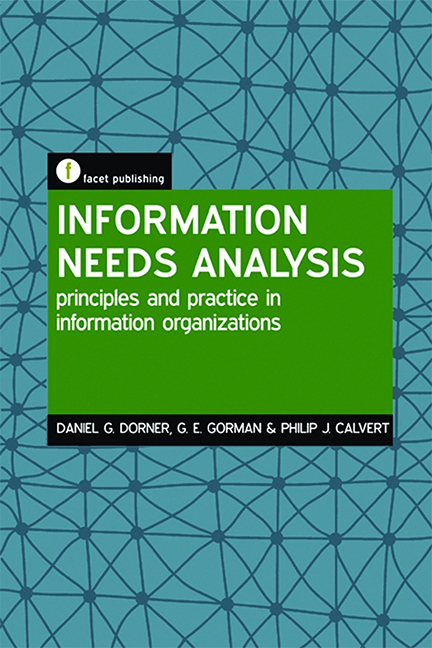Book contents
- Frontmatter
- Contents
- List of figures and tables
- List of scenarios
- About the authors
- Preface
- 1 Background to needs analysis for information managers
- 2 The importance of context in information needs analysis
- 3 Models and types of information needs analysis
- 4 The stages of information needs analysis
- 5 Gathering data for information needs analyses
- 6 Gathering data from existing sources
- 7 Gathering data through surveys
- 8 Gathering data through interviews
- 9 Analysing and integrating information needs analysis data
- 10 Reporting on an information needs analysis
- Bibliography
- Index
7 - Gathering data through surveys
Published online by Cambridge University Press: 10 September 2022
- Frontmatter
- Contents
- List of figures and tables
- List of scenarios
- About the authors
- Preface
- 1 Background to needs analysis for information managers
- 2 The importance of context in information needs analysis
- 3 Models and types of information needs analysis
- 4 The stages of information needs analysis
- 5 Gathering data for information needs analyses
- 6 Gathering data from existing sources
- 7 Gathering data through surveys
- 8 Gathering data through interviews
- 9 Analysing and integrating information needs analysis data
- 10 Reporting on an information needs analysis
- Bibliography
- Index
Summary
Introduction
Chapter 5 introduced several methods for gathering data for INAs. Following that introductory chapter, Chapter 6 then began the in-depth discussion of methods by addressing the use of existing, or historical, data. Chapter 7 now continues the in-depth discussion by focusing on the survey, a quantitative data-gathering tool frequently used in INAs. Before continuing it is necessary to say that surveys are not the only source of quantitative data; numerical data can be collected from a variety of sources ranging from interviews and observations to web server log files. The survey, though, is by far the most common method for collecting quantitative data for INA.
A well designed quantitative study can produce reliable, robust, generalizable results. Chapter 5 noted that surveys can produce data for an INA to show, for example, that end-users favour one kind of information resource over another, or that clients are dissatisfied with a specific element of the information service. Another common method of collecting data for an INA, the use of structured groups, is discussed in Chapter 8; and the analysis and integration of data are covered in Chapter 9.
In this chapter the focus on surveys as a data-gathering method addresses three principal questions:
1 Most basically, what is a survey, and how do surveys fit into INA?
2 What are the planning procedures for conducting a survey?
3 How do we conduct a survey?
What is a survey?
Surveys as part of an INA project
The methods used to collect data within an INA may be simple or multi-faceted. Sometimes in an INA a survey is the only method of data gathering employed, but often a survey is used in conjunction with other research methods in a mixed methods process (introduced in Chapter 5). Thus a survey of a particular client group may be used as part of a concurrent or sequential series of data-gathering exercises that might include examining existing data (see Chapter 6) and gathering qua litative information through interviews, focus groups and other methods (see Chapter 8).
Survey results can suggest patterns in actions and behaviour (telling us what is happening), while the qualitative methods of data gathering are more appropriate for exploring why something is occurring based on the opinions and attitudes of the people involved.
- Type
- Chapter
- Information
- Information Needs AnalysisPrinciples and Practice in Information Organizations, pp. 139 - 160Publisher: FacetPrint publication year: 2017



